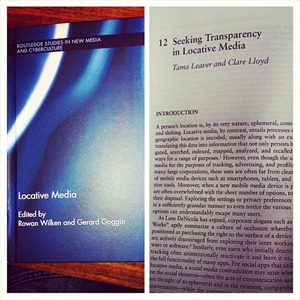CFP: ‘Beginnings’
 Bjorn Nansen and I are editing an issue of M/C A Journal of Media and Culture on the (deliberately and we hope, provocatively) broad topic of ‘Beginnings’. The Call for Papers has just been released, and is reproduced below for your convenience:
Bjorn Nansen and I are editing an issue of M/C A Journal of Media and Culture on the (deliberately and we hope, provocatively) broad topic of ‘Beginnings’. The Call for Papers has just been released, and is reproduced below for your convenience:
‘beginnings’
The digital spaces we encounter are increasingly stabilised and structured, organised through regulatory and commercial regimes, and populated by content and users whose lives began already networked in digital forms of production, distribution and consumption. This issue of M/C Journal seeks to explore the beginnings of these familiar and well-established, as well as emerging, contexts of digital cultures. By focussing on the beginnings, of life, of platforms, of technological encounters, of existence on social media, and so on, this issue aims to bring together scholarship around the infant and initial moments of technology use, and the processes, relations and forces that shape and are shaped by these beginnings. As digital culture becomes increasingly banal and thus less visible, studying digital beginnings may help to illuminate the varied forms of meaning, mediation, and materiality at play in configuring the familiar. Exploring beginnings may also serve to highlight paths not taken, as well as potential alternatives produced at such interstices.
Questions of beginnings feature within research traditions and theories of technology adoption, domestication and development, and so can be understood in reference to individuals and users, but also apply to the beginnings of social groups and movements, or the birth of applications, platforms, technologies or enterprises. Studying beginnings, therefore, raises questions about digital histories, trajectories and temporalities, and is open to empirical, methodological or theoretical enquiries.
By inviting contributions interested in exploring digital beginnings in this issue of M/C, possible topics to be addressed may include, but are not limited to:
- The mediation of the unborn and newly born
- New parents and social media platforms
- Case studies or examples of infant media use
- Newbs and noobs in gaming or online communities
- The cultural implications of new forms of computational interfaces (e.g. the Internet of Things)
- Myths of new beginnings and technological exceptionalism (e.g. 3D printing)
- Early historical perspectives on digital media industries or events
- Start-up spaces or cultures
- Alternate beginnings (eg failed and forgotten inventions)
Prospective contributors should email an abstract of 100-250 words and a brief biography to the issue editors. Abstracts should include the article title and should describe your research question, approach, and argument. Biographies should be about three sentences (maximum 75 words) and should include your institutional affiliation and research interests. Articles should be 3000 words (plus bibliography). All articles will be refereed and must adhere to MLA style (6th edition).
Details
- Article deadline: 14 Aug. 2015
- Release date: 14 Oct. 2015
- Editors: Bjorn Nansen and Tama Leaver
Please submit articles through this Website. Send any enquiries to beginnings@journal.media-culture.org.au.
Needless to say, enquiries are welcome, and early submissions, too!
[Image: 4/366: Beginning by Magic Madzik CC BY]
New chapter: Seeking Transparency in Locative Media
 The newly-released edited collection Locative Media by Rowan Wilken and Gerard Goggin features a chapter from Clare Lloyd and me looking at issues of privacy and transparency relating to the data generated, stored and analysed when using mobile and locative-based services. Here’s the abstract:
The newly-released edited collection Locative Media by Rowan Wilken and Gerard Goggin features a chapter from Clare Lloyd and me looking at issues of privacy and transparency relating to the data generated, stored and analysed when using mobile and locative-based services. Here’s the abstract:
A person’s location is, by its very nature, ephemeral, continually changing and shifting. Locative media, by contrast, is created when a device encodes a users’ geographic location, and usually the exact time as well, translating this data into information that not only persists, but can be aggregated, searched, indexed, mapped, analysed and recalled in a variety of ways for a range of purposes However, while the utility of locative media for the purposes of tracking, advertising and profiling is obvious to many large corporations, these uses are far from transparent for many users of mobile media devices such as smartphones, tablets and satellite navigation tools. Moreover, when a new mobile media device is purchased, users are often overwhelmed with the sheer number of options, tools and apps at their disposal. Often, exploring the settings or privacy preferences of a new device in a sufficiently granular manner to even notice the various location-related options simply escapes many new users. Similarly, even those who deactivate geolocation tracking initially often unintentionally reactivate it, and leave it on, in order to use the full functionality of many apps. A significant challenge has thus arisen: how can users be made aware of the potential existence and persistence of their own locative media? This chapter examines a number of tools and approaches which are designed to inform everyday users of the uses, and potential abuses, or locative media; PleaseRobMe, I Can Stalk U, iPhone Tracker and the aptly named Creepy. These awareness-raising tools make visible the operation of certain elements of locative media, such as revealing the existence of geographic coordinates in cameraphone photographs, and making explicit possible misuses of a visible locative media trail. All four are designed as pedagogical tools, aiming to make users aware of the tools they are already using. In an era where locative media devices are easy to use but their ease occludes extremely complex data generation and potential tracking, this chapter argues that these tools are part of a significant step forward in developing public awareness of locative media, and related privacy issues.
A version of the chapter is available at Academia.edu (and just for fun, the book has a 2015 publication date, so at the moment, it’s *from the future*!)
Academy Awards for Performing Animals?
Here’s a little piece I had in today’s Conversation …
Oscars for animals? Andy Serkis should be beating his chest
By Tama Leaver, Curtin University
The notion that a chimpanzee could win an Academy Award for acting (or anything else) seems farcical at first glance but, of course, it’s not an actual chimpanzee being discussed in the case of the latest role by Andy Serkis.
Rather, it’s an incredibly sophisticated amalgam of the actor and the very latest computational visualisation techniques from Weta Digital.
Serkis’ performance as Caesar, the leader of the fledgling ape society in the recently-released Dawn of the Planet of the Apes (2014) once again has Hollywood commentators pondering the possibility of an Oscar nod for a synthespian – a synthetic thespian or virtual actor – but this is far from the first time this question has been raised.

Andy Serkis has been behind some of the most memorable cinematic faces of the last decade, but it’s not quite his face. Rather, Serkis has held pioneering roles utilising performance capture technology.
Performance capture features the real-time recording and digitisation of an actor’s movements, which are then used to drive a complex digital model.
With the digital powerhouse of Weta Digital behind him, Serkis’ performances have driven Gollum from The Lord of the Rings (2001, 2002, 2003) (and now The Hobbit – 2012, 2013, 2014) films, the titular ape in Peter Jackson’s King Kong (2005), and the role of Caesar in Rise of the Planet of the Apes (2011) and the new sequel, Dawn.
For many, the question of where the acting ends and the computer-generated imagery begins, undermines the authenticity of a performance captured role as a performance, but no performance exists in a vacuum. Every actor’s appearance is constructed through costume, make-up and lighting, their dialogue taken from a script, the eventual role on screen painstakingly led by a director, and carefully filtered and refined during the editing process.
Performance capture is similar in many ways, but with the additional digital processing to translate the motion and facial expressions of an actor onto an often non-human character.
In a brief promotional featurette, Serkis explains how the performance capture technology has developed, with scenes now able to be shot outdoors where once they had to be on a soundstage against a green screen.
Most significantly though, for Serkis, is the fidelity with which the performance capture cameras and software can directly map an actors’ face and performance onto the digital character they are playing.
And given that technology has always been part of acting, the authenticity of performance captured roles speaks to the symbiotic relationship between fleshy, embodied actors and the informatic machines that enhance and facilitate those performances.
Early industry fears that synthespians might replace “real” actors reveals an insecurity about the relationship between people and technology. If a character can simply be created by a computer, the millions of dollars spent on A-list stars might just seem a little unnecessary.
The reality of performance capture, though, shows the opposite to be true: its takes a huge team to bring a single performance capture character to screen, with the actor remaining integral, filmed in excruciating detail, but also then combining software engineers, digital artists, and a range of other digital effects personnel to keep the best of the performance and use it to drive a state-of-the-art digital model.

Yet every director and crew who have worked with Serkis since his days as Gollum, as well as Serkis himself, have spent over a decade arguing for the legitimacy of performance capture as “real” acting.
After the pivotal role of Serkis in The Lord of the Rings: The Two Towers (2002), New Line Cinema and director Peter Jackson led the first attempt to get a role driven by performance capture acknowledged at the Academy Awards.
In his first outing as Caesar, Serkis was widely applauded, with 20th Century Fox mounting a campaign for a best actor nomination. Co-star James Franco was particularly vocal in arguing that Serkis’ performance was integral to the character, worthy of critical attention and praise.
And with the success of Dawn, the director and co-stars are once again lining up to applaud Serkis’ performance.
In terms of literally performing animals, Serkis and the team playing the various apes in the film do a remarkable job in evoking empathy without sacrificing the specificities of chimpanzees and other apes.
It is noteworthy that Rise received a specific commendation from PETA (People for the Ethical Treatment of Animals) about the way animals were portrayed and filmed. Having a human actor behind the animal performances not only guarantees no animals will be harmed on set, but at a deeper level also begs the question about the relationships between humans and animals.
Such questions are at the heart of Dawn, wherein the similarities between apes and humans drive the plot rather than intrinsic differences.
Andy Serkis’ role as Caesar is central to Dawn, and as numerous online features emphasise, this is his acting, and his performance. Whether this is the year that such a digital performance is captured by the Oscars or not remains to be seen.
![]()
Tama Leaver receives funding from the Australian Research Council (ARC).
This article was originally published on The Conversation. Read the original article.
Mapping the Ends of Identity on Instagram
At last week’s Australian and New Zealand Communication Association (ANZCA) conference at Swinburne University in Melbourne I gave a new paper by myself and Tim Highfield entitled ‘Mapping the Ends of Identity on Instagram’. The slides, abstract, and audio recording of the talk are below:
While many studies explore the way that individuals represent themselves online, a less studied but equally important question is the way that individuals who cannot represent themselves are portrayed. This paper outlines an investigation into some of those individuals, exploring the ends of identity – birth and death – and the way the very young and deceased are portrayed via the popular mobile photo sharing app and platform Instagram. In order to explore visual representations of birth and death on Instagram, photos with four specific tags were tracked: #birth, #ultrasound, #funeral and #RIP. The data gathered included quantitative and qualitative material. On the quantitative front, metadata was aggregated about each photo posted for three months using the four target tags. This includes metadata such as the date taken, place taken, number of likes, number of comments, what tags were used, and what descriptions were given to the photographs. The quantitative data gives also gives an overall picture of the frequency and volume of the tags used. To give a more detailed understanding of the photos themselves, on one day of each month tracked, all of the photographs on Instagram using the four tags were downloaded and coded, giving a much clearer representative sampling of exactly how each tag is used, the sort of photos shared, and allowed a level of filtering. For example, the #ultrasound hashtag includes a range of images, not just prenatal ultrasounds, including both current images (taken and shared at that moment), historical images, collages, and even ultrasound humour (for example, prenatal ultrasound images with including a photoshopped inclusion of a cash, or a cigarette, joking about the what the future might hold). This paper will outline the methods developed for tracking Instagram photos via tags, it will then present a quantitative overview of the uses and frequency of the four hashtags tracked, give a qualitative overview of the #ultrasound and #RIP tags, and conclude with some general extrapolations about the way that birth and death are visually represented online in the era of mobile media.
And the audio recording of the talk is available on Soundcloud for those who are willing to brave the mediocre quality and variable volume (because I can’t talk without pacing about, it seems!).
Facebook in Education: Special Issue of Digital Culture & Education

I’m pleased to announced that the special themed issue of Digital Culture and Education on Facebook in Education, edited by Mike Kent and I, has been released. The issue features an introductory article by Mike and I, ‘Facebook in Education: Lessons Learnt’ in which we may have some opinions about whether the hype around MOOCs and disruptive online education ignores the very long history of learning online (hint: it does). As something of a corrective to that hype, this issue explores different aspects of the complicated relationship between Facebook as a platform and learning and teaching in higher education.
This issue features ‘“Face to face” Learning from others in Facebook Groups‘ by Eleanor Sandry, ‘Exploiting fluencies: Educational expropriation of social networking site consumer training‘ by Lucinda Rush and D.E. Wittkower, ‘Learning or Liking: Educational architecture and the efficacy of attention‘ by Leanne McRae, and ‘Separating Work and Play: Privacy, Anonymity and the Politics of Interactive Pedagogy in Deploying Facebook in Learning and Teaching’ by Rob Cover.
Also, watch this space in about a month for the related and slightly larger related work in the same area.
Is Facebook finally taking anonymity seriously?
By Tama Leaver, Curtin University and Emily van der Nagel, Swinburne University of Technology
Having some form of anonymity online offers many people a kind of freedom. Whether it’s used for exposing corruption or just experimenting socially online it provides a way for the content (but not its author) to be seen.
But this freedom can also easily be abused by those who use anonymity to troll, abuse or harass others, which is why Facebook has previously been opposed to “anonymity on the internet”.
So in announcing that it will allow users to log in to apps anonymously, is Facebook is taking anonymity seriously?
Real identities on Facebook
CEO Mark Zuckerberg has been committed to Facebook as a site for users to have a single real identity since its beginning a decade ago as a platform to connect college students. Today, Facebook’s core business is still about connecting people with those they already know.
But there have been concerns about what personal information is revealed when people use any third-party apps on Facebook.
So this latest announcement aims to address any reluctance some users may have to sign in to third-party apps. Users will soon be able to log in to them without revealing any of their wealth of personal information.

That does not mean they will be anonymous to Facebook – the social media site will still track user activity.
It might seem like the beginning of a shift away from singular, fixed identities, but tweaking privacy settings hardly indicates that Facebook is embracing anonymity. It’s a long way from changing how third-party apps are approached to changing Facebook’s entire real-name culture.
Facebook still insists that “users provide their real names and information”, which it describes as an ongoing “commitment” users make to the platform.
Changing the Facebook experience?
Having the option to log in to third-party apps anonymously does not necessarily mean Facebook users will actually use it. Effective use of Facebook’s privacy settings depends on user knowledge and motivation, and not all users opt in.
A recent Pew Research Center report reveals that the most common strategy people use to be less visible online is to clear their cookies and browser history.
Only 14% of those interviewed said they had used a service to browse the internet anonymously. So, for most Facebook users, their experience won’t change.
Facebook login on other apps and websites

Facebook offers users the ability to use their authenticated Facebook identity to log in to third-party web services and mobile apps. At its simplest and most appealing level, this alleviates the need for users to fill in all their details when signing up for a new app. Instead they can just click the “Log in with Facebook” button.
For online corporations whose businesses depend on building detailed user profiles to attract advertisers, authentication is a real boon. It means they know exactly what apps people are using and when they log in to them.
Automated data flows can often push information back into the authenticating service (such as the music someone is playing on Spotify turning up in their Facebook newsfeed).
While having one account to log in to a range of apps and services is certainly handy, this convenience means it’s almost impossible to tell what information is being shared.
Is Facebook just sharing your email address and full name, or is it providing your date of birth, most recent location, hometown, a full list of friends and so forth? Understandably, this again raises privacy concerns for many people.
How anonymous login works
To address these concerns, Facebook is testing anonymous login as well as a more granular approach to authentication. (It’s worth noting, neither of these changes have been made available to users yet.)
Given the long history of privacy missteps by Facebook, the new login appears to be a step forward. Users will be told what information an app is requesting, and have the option of selectively deciding which of those items Facebook should actually provide.
Facebook will also ask users whether they want to allow the app to post information to Facebook on their behalf. Significantly, this now places the onus on users to manage the way Facebook shares their information on their behalf.
In describing anonymous login, Facebook explains that:
Sometimes people want to try out apps, but they’re not ready to share any information about themselves.
It’s certainly useful to try out apps without having to fill in and establish a full profile, but very few apps can actually operate without some sort of persistent user identity.
The implication is once a user has tested an app, to use its full functionality they’ll have to set up a profile, probably by allowing Facebook to share some of their data with the app or service.
Taking on the competition
The value of identity and anonymity are both central to the current social media war to gain user attention and loyalty.
Facebook’s anonymous login might cynically be seen as an attempt to court users who have flocked to Snapchat, an app which has anonymity built into its design from the outset.
Snapchat’s creators famously turned down a US$3 billion buyout bid from Facebook. Last week it also revealed part of its competitive plan, an updated version of Snapchat that offers seamless real-time video and text chat.
By default, these conversations disappear as soon as they’ve happened, but users can select important items to hold on to.
Whether competing with Snapchat, or any number of other social media services, Facebook will have to continue to consider the way identity and anonymity are valued by users. At the moment its flirting with anonymity is tokenistic at best.
![]()
Tama Leaver receives funding from the Australian Research Council (ARC).
Emily van der Nagel does not work for, consult to, own shares in or receive funding from any company or organisation that would benefit from this article, and has no relevant affiliations.
This article was originally published on The Conversation. Read the original article.
